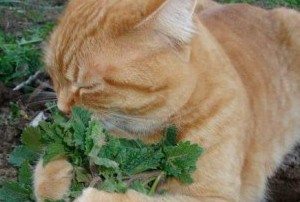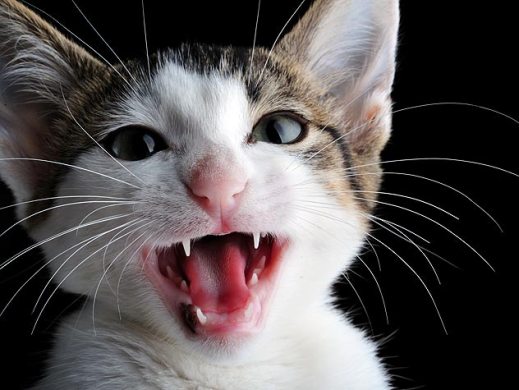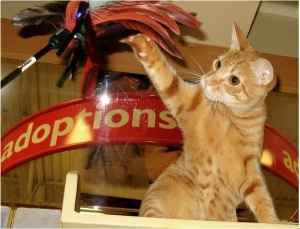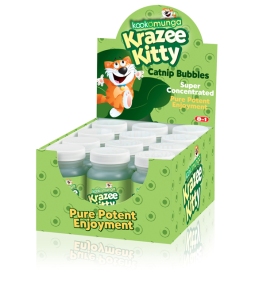Do You Play With Your Cat Daily? Here’s Why You Should

There are few things more entertaining than watching a cat thoroughly engaged in play, and it is also one of the most vital aspects of a cat’s well-being. Unfortunately, many cat owners underestimate it’s importance. Daily interactive play sessions can improve your cat’s overall health and decrease the occurrence of negative behaviors. Additionally, it can become a bonding ritual for you and your cat.
Both wild and domestic cats sleep most of the day, but wild cats spend nearly all of their waking hours in active pursuit of food. Since house cats get their meals served to them on a silver platter, it is important to recreate that hunting time to keep them physically fit and mentally stimulated. Without proper outlets to expend energy, cats become bored, overweight, or depressed. Often, without interactive and energizing play, cats will find other ways to disperse their pent up energy and stress, typically through negative behaviors like excessive howling, compulsive grooming, increased need for attention (not always a bad thing!), or general household destruction.
First, let’s clarify what ‘interactive’ playtime means. It does not mean tossing your cat a few fuzzy mice and calling it a day, it requires a teeny bit of work on your part to get your cat moving. You need a toy your cat will love, usually a pole, string, or dangle type (my favorites include Cat Dancer and Da Bird) to get him or her pouncing, bounding, leaping, and ambushing.
Remember that playtime is as much a mental exercise as a physical one, so it keeps your cat’s mind sharp and body active. Allowing cats to express their hunting instincts (and to ‘catch their prey’) builds their confidence, so this is a wonderful tool to encourage timid cats to come out of their shell or become more confident around others in a multi-cat household.
How to Play: Playtime should occur on a regular basis, ideally twice a day for 15-20 minutes each time. When using pole, string, or similar toys, don’t just dangle it in front of their face. Try to imitate how your cat plays or how she might hunt. If your cat starts to pant, you’re doing it right! Let her catch and grasp the ‘prey’ sometimes so she feels successful. Be sure to have a short ‘cool down’ session towards the end, just like you would during a gym workout. Rotating the toys periodically will make old ones new again, and keep things fresh and exciting.
If you don’t think you can commit to regular playtime, you should consider buying a puzzle feeder. Puzzle feeders require the cat to work a little in order to reach the food, which like playtime, stimulates a cat’s hunting instincts an keeps them active. As a bonus, puzzle feeders force a cat to eat slower, which is good for overweight cats and those that eat too quickly and vomit afterwards. The Stimulo Interactive Cat Feeder is a great one, and if you buy it from this link, proceeds will benefit Pet Adoption Network. Other interactive games, like the CatAmazing puzzle-box, are wonderful for keeping your cat or cats kindled while you are at work.
Other Tips: Don’t do play-time on or around your bed- if you do, kitty will associate physical activity with that area and might keep you up at night. Also, don’t use your hands or fingers during play, especially with kittens. This reinforces the idea that fingers are toys- something to go after and teeth on- and will encourage negative biting behaviors. You might consider following playtime with feeding time to hone in on your cats ‘hunt-kill-eat’ instincts, which is typically followed by grooming and sleeping. This tip is especially helpful if your cat is keeping you up at night.
Remember, an active cat is healthier and a mentally-stimulated cat is happier; therefore, they will not need to redirect energy into destructive behaviors. Playtime will benefit not only your cat, but your home and your bond with them.
Catnip 101: Giving Cats a ‘Chesire Grin’

Ah, catnip. Few things are more fun than watching your cat roll around in a euphoric daze, high on a feline’s marijuana. But what exactly is the herb and why do cats react that way? Is it safe? Do big cats like lions and tigers react to catnip too? (Big Cat Rescue says yes!)
Catnip (Nepata cataria) is a member of the mint family and is distantly related to marijuana. It is not, however, the male cannabis plant as some people believe. Also known as catswort, catmint, catrup and field balm, catnip is a perennial plant native to Europe, but is now common in North American gardens and nurseries. When in full bloom it sports a purple flower that attracts butterflies and keeps away aphids, making it a gardener’s friend.
Nepatalactone is the chemical compound that, when smelled through specialized nasal receptors (, triggers the frenzied feline response. Cats typically roll around and seem excited and euphoric, yet relaxed. They chin-rub like crazy. Cat behaviorist Amy D. Shojai (from ‘Cats 101’ on Animal Planet) says catnip triggers the ‘same biophysical pathways’ as LSD and marijuana does in humans, and calls catnip a ‘feline hallucinogen.’ Some cats eat the plant, which is fine (munchies, maybe?).
Catnip can be used to calm stressed cats (I use it when working with cats who are frightened or cautious with humans to help them relax) or simply offered as a new activity to change things up. It is also used with much success when encouraging cats to scratch on cardboard posts or sisal towers instead of couches or carpets. The initial reaction lasts a short time, typically wearing off in less than ten minutes. After that, a cat will not react again for at least an hour or two. There is a general consensus amongst veterinarians and cat behaviorists that catnip is harmless when used moderately, but long-term overuse may result in decreased awareness or confusion, according to Cat Owner’s Home Veterinary Handbook.
Catnip ‘highs’ are not universal; that is, not all cats react to the herb. The sensitivity is hereditary, and anywhere from one-third to one-half of cats will have no reaction whatsoever, and that is perfectly normal. Also, kittens under six months of age rarely react, possibly because they are still reaching sexual maturity, as it is thought that the reaction to the nepatalactone in catnip mimics feline pheromones, such as those spread by males who urine-mark or females in heat. Catnip oil has been used, unfortunately, by bobcat trappers.
You can buy catnip stuffed in toys, in liquid spray form, near-bulk quantity of dried leaves, catnip-flavored treats, seeds for growing your own indoors, or plant some in your garden (it keeps away aphids and attracts butterflies!). Oh, yeah, catnip comes in bubbles too!
Humans don’t typically get any kind of high from catnip, and you shouldn’t give your cat marijuana, either. Don’t be stupid. You can, however, make a catnip tea that is a homeopathic recipe to soothe insomnia and upset stomachs.




